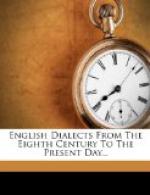We know that, in 1386, the poet Chaucer was elected a knight of the shire for Kent, and in 1392-3 he was residing at Greenwich. He evidently knew something of the Kentish dialect; and he took advantage of the circumstance, precisely as Gower did, for varying his rimes. The earliest example of this is in his Book of the Duchess, l. 438, where he uses the Kentish ken instead of kin (A.S. cynn) in order to secure a rime for ten. In the Canterbury Tales, E 1057, he has kesse, to kiss (A.S. cyssan), to rime with stedfastnesse. In the same, A 1318, he has fulfille, to fulfil (cf. A.S. fyllan, to fill), to rime with wille; but in Troilus, iii 510, he changes it to fulfelle, to rime with telle; with several other instances of a like kind.
It is further remarkable that some Kentish forms seem to have established themselves in standard English, as when we use dent with the sense of dint (A.S. dynt). When we speak of the left hand, the form left is really Kentish, and occurs in the Ayenbite of Inwyt; the Midland form is properly lift, which is common enough in Middle English; see the New English Dictionary, s.v. Left, adj. Hemlock is certainly a Kentish form; cf. A.S. hymlice, and see the New English Dictionary. So also is kernel (A.S. cyrnel); knell (A.S. cnyllan, verb); merry (A.S. myrge, myrige); and perhaps stern, adj. (A.S. styrne).
There are some excellent remarks upon the vocalism of the Kentish dialect in Middle English by W. Heuser, in the German periodical entitled Anglia, vol XVII pp. 73-90.
CHAPTER VIII
THE MERCIAN DIALECT
I. EAST MIDLAND
The Mercian district lies between the Northern and Southern, occupying an irregular area which it is very difficult to define. On the east coast it reached from the mouth of the Humber to that of the Thames. On the western side it seems to have included a part of Lancashire, and extended from the mouth of the Lune to the Bristol Channel, exclusive of a great part of Wales.
There were two chief varieties of it which differed in many particulars, viz. the East Midland and the West Midland. The East Midland included, roughly speaking, the counties of Lincoln, Rutland, Northampton, and Buckingham, and all the counties (between the Thames and Humber) to the east of these, viz. Cambridge, Huntingdon, Bedford, Hertford, Middlesex, Norfolk, Suffolk, and Essex. We must also certainly include, if not Oxfordshire, at any rate the city of Oxford. This is by far the most important group of counties, as it was the East Midland that finally prevailed over the rest, and was at last accepted




